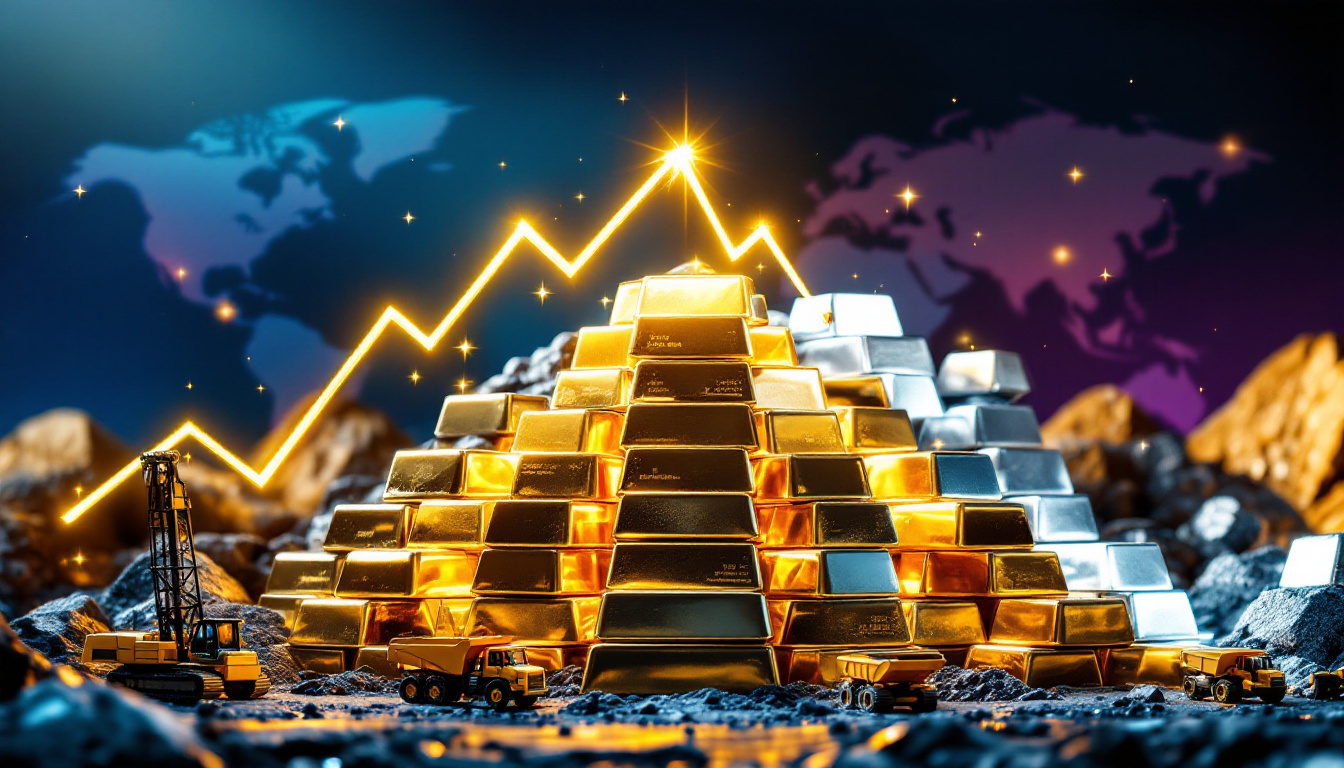What is Gallium and Why is it Important?
Understanding Gallium's Properties and Applications
Gallium is a soft, silver-blue metal with remarkable properties, including a low melting point of just 29.76°C that allows it to be liquid at near room temperature. This critical mineral has become indispensable in modern technology, primarily used in semiconductors, transistors, LEDs, computer chips, and various defense applications.
The metal's compounds, particularly gallium nitride (GaN) and gallium arsenide (GaAs), possess exceptional electrical properties that make them superior to traditional silicon in many applications. GaN's wide bandgap enables more efficient power conversion, reducing energy losses by up to 30% compared to silicon-based systems in applications like electric vehicle charging infrastructure.
Beyond electronics, gallium's applications are expanding rapidly into new frontiers including advanced robotics, fast-charging technology, and high-performance neodymium iron boron magnets. The U.S. Department of Defense classifies gallium as a strategic material due to its critical role in phased-array radars and missile guidance systems, with GaAs-based radio frequency chips being essential components in advanced military aircraft like the F-35 fighter jet.
Due to its strategic importance in both civilian and military technologies, gallium has been officially listed as a critical mineral shortages by the United States, European Union, and Australia. This designation recognizes not only gallium's technological importance but also the supply chain vulnerabilities associated with its production.
The Growing Global Gallium Market
The economic significance of gallium is reflected in its rapidly expanding market. Global demand is projected to grow from US$2.45 billion in 2024 to US$5.38 billion by 2028, eventually reaching US$21.53 billion by 2034. This represents a compound annual growth rate (CAGR) of 24.3% – one of the fastest-growing segments in the critical minerals sector.
In volume terms, 2023 demand was approximately 708 tonnes, with forecasts suggesting this will increase to 1,180 tonnes by 2030. This growth is driven primarily by expanding applications in 5G infrastructure, electric vehicle technology, and renewable energy systems.
The market's expansion is creating significant opportunities for investors and mining companies, particularly as nations seek to reduce dependence on Chinese supply. However, this growth is occurring against a backdrop of increasing geopolitical strategies and supply chain vulnerabilities that have created unprecedented price volatility.
How Have Chinese Export Controls Affected the Gallium Market?
China's Dominance in Gallium Production
China's control over the global gallium supply chain is nearly absolute, with the country accounting for 98.4% of global gallium production in 2024. This dominance stems from China's strategic investment in extracting gallium as a byproduct of its massive alumina refining industry.
Chinese production facilities have an estimated capacity of up to 1,200 tonnes per annum, with operations concentrated in key regions like Shandong province. The Shandong Hongdefa Group alone operates six plants with a combined capacity of approximately 600 tonnes per annum, leveraging economies of scale that Western competitors struggle to match.
Beyond primary production, China also controls the manufacturing of most reagents used in gallium processing, particularly specialized cation-exchange resins that are essential for extraction. This vertical integration gives Chinese producers a significant cost advantage, with production costs estimated to be 60% lower than those of Western counterparts.
Timeline of Export Restrictions
The gallium market underwent a seismic shift in mid-2023 when China implemented initial export restrictions impact on gallium and germanium, requiring special export licenses. These measures had an immediate impact, reducing shipments to the European Union by 72% within a single month and creating supply shortages for Western manufacturers.
The situation escalated dramatically in December 2024 when China announced an outright export ban of gallium and Chinese export controls to the United States. This comprehensive ban extended beyond raw materials to include gallium-related technology exports, effectively cutting off Western access to both the material and the expertise needed to process it.
These restrictions were widely interpreted as retaliation for the Biden Administration's expanded limitations on advanced U.S. technology sales to China, particularly in the semiconductor sector. The restrictions exemplify how critical minerals have become pawns in the broader critical minerals race between global powers.
Market Impact of Export Controls
The most immediate consequence of China's export controls has been the creation of a bifurcated market with two distinct pricing structures. The Rotterdam (international) price reached US$680/kg in early 2025, while the Chinese domestic price remained around US$220/kg – creating a 209% premium for Western buyers.
This price divergence has caused significant supply chain disruptions for Western manufacturers, particularly in the semiconductor and defense sectors. Companies like Intel and TSMC have reported production constraints and increased input costs, with some semiconductor manufacturers exploring redesigns to reduce gallium dependence.
The restrictions have also accelerated efforts to develop non-Chinese supply chains, with both private companies and governments investing in alternative production capabilities. The U.S. Defense Logistics Agency has allocated US$150 million for strategic gallium stockpiles, aiming to secure 25 tonnes per annum through 2030 to insulate critical defense applications from supply disruptions.
How is Gallium Produced?
Primary Production Methods
Gallium is primarily recovered as a by-product of alumina refining in the Bayer process. During alumina production, gallium concentrates in the sodium hydroxide solution (Bayer liquor) used to dissolve aluminum from bauxite ore. Specialized extraction methods then separate gallium from this solution.
Despite being relatively abundant in the Earth's crust – approximately as common as copper – gallium rarely exists in concentrations high enough to justify mining it as a primary product. Typical bauxite ores contain only 50-100 parts per million gallium, meaning that processing approximately 10,000 tonnes of alumina yields just 1 kilogram of gallium.
The extraction process involves multiple complex steps including precipitation, solvent extraction, and electrolysis to achieve the 99.99% purity (4N) required for semiconductor applications. Further purification to 99.9999% (6N) or even 99.99999% (7N) is necessary for the most demanding applications such as high-performance LEDs and solar cells.
Production Challenges Outside China
Establishing gallium production outside China faces numerous obstacles, beginning with securing access to key reagents, particularly ion-exchange resins, at competitive prices. China's control of specialized resins like Amberlite IRC120, which require rare earth catalysts produced primarily in Jiangxi province, creates significant cost disadvantages for Western producers.
The economics of gallium production are also challenging, with high capital costs of approximately US$150 million required to build a 40-50 tonne per annum gallium refinery. These investments are difficult to justify when gallium typically contributes only 1-2% of revenue compared to alumina in integrated operations.
Technical expertise represents another significant barrier, as China has systematically developed processing know-how over decades. Western companies face a steep learning curve in mastering the complex extraction and purification technologies, particularly as Chinese expertise has become increasingly inaccessible due to technology export restrictions.
Non-Chinese Production Initiatives
Despite these challenges, several non-Chinese production initiatives are underway. In Germany, Vital Pure Metal Solutions currently produces small amounts of gallium (approximately 12 tonnes per annum), while AOS Stade is planning to resume production at a facility that was previously shuttered due to Chinese competition.
In Greece, Metlen has announced plans to produce 50 tonnes per annum from 2028, potentially becoming Europe's largest gallium producer. The project is partially supported by EU critical minerals funding, reflecting the strategic priority that European policymakers now place on securing gallium supply.
Canada is emerging as another potential gallium supplier, with Rio Tinto building a demonstration plant in Quebec capable of producing 3.5 tonnes per annum. This facility could potentially expand to a 40 tonne per annum commercial plant if market conditions support the investment.
In North America, Neo Performance Materials (backed by Wyloo Metals) stands as the only recycler of semiconductor-grade gallium, recovering approximately 8 tonnes per annum from manufacturing waste. The company has partnered with major semiconductor manufacturers to expand recycling capacity to 15 tonnes per annum by 2026.
Australia's MTM Critical Metals is pursuing a different technological approach, building a 1 tonne per annum demonstration plant in Texas that utilizes innovative Flash Joule Heating technology. This method enables gallium extraction from aluminum smelter waste and could potentially bypass some of the reagent dependencies that challenge conventional production.
Which ASX Companies Are Developing Gallium Projects?
Leading ASX Gallium Players
RareX (ASX:REE) has reported the highest gallium grades in Australia at its Cummins Range rare earths project, with assays showing up to 6,826g/t gallium in lateritic clays. These exceptional grades, the highest reported outside China, are complemented by a novel glycine-leach process that achieves 94% recovery rates. The company is advancing a preliminary feasibility studies insights that includes gallium as a significant value-add to its primary rare earths focus.
Western Yilgarn (ASX:WYX) is pursuing a different approach, advancing bauxite licenses with promising gallium mineralization of up to 110g/t. The company's Julimar West project is conducting vacuum drilling campaigns with the aim of defining a 50 million tonne resource by the third quarter of 2025. The proximity to existing alumina refineries provides potential processing synergies that could reduce capital requirements.
Victory Metals (ASX:VTM) has achieved a significant technical milestone by successfully producing gallium in mixed rare earth carbonate from its North Stanmore project. This demonstration of metallurgical feasibility represents an important step toward commercial production, with the company targeting first production by 2027.
G50 Corp (ASX:G50) established itself as an early mover in the gallium space when it discovered a gallium "halo" at its Golconda project in Arizona. The company is exploring the potential for direct gallium mining, a relatively unusual approach given gallium's typical recovery as a byproduct. Initial results suggest grades of up to 95g/t gallium in near-surface deposits.
Nimy Resources (ASX:NIM) has established an exploration target of 9.6-14.3 million tonnes at 39-78ppm gallium at its Mons project. While these grades are lower than some competitors, the company has forged a collaboration with Curtin University to develop selective leaching technologies that could make lower-grade resources economically viable.
Emerging Players and Early-Stage Exploration
Aruma Resources (ASX:AAJ) is conducting early-stage gallium exploration at its Saltwater project in Western Australia. Initial surface sampling has returned promising results, though comprehensive drilling campaigns will be required to define the resource potential.
Axel REE (ASX:AXL) has identified gallium potential at its Caladão project in Brazil, where historic data suggests gallium concentrations of up to 82g/t in weathered granite. The company is planning a targeted drilling program to better understand the distribution and recovery potential of these gallium occurrences.
MTM Critical Metals (ASX:MTM) stands out for its technological approach, developing proprietary Flash Joule Heating technology for gallium extraction. This innovative method applies high-voltage electrical pulses to aluminum smelter waste, liberating gallium without the need for conventional reagents. The company's 1 tonne per annum demonstration plant in Texas represents a potential paradigm shift in gallium production economics if successfully scaled.
What is Australia's History with Gallium Production?
The Pinjarra Gallium Plant
Australia has significant historical experience with gallium production, most notably through the Pinjarra gallium plant that opened in 1989. This facility, constructed by French chemical company Rhône-Poulenc, represented a $50 million investment with an impressive 50 tonne per annum production capacity – equivalent to 20-30% of global demand at that time.
The plant was strategically positioned to utilize liquor from Alcoa's neighboring alumina refinery, exemplifying the synergistic relationship between alumina refining and gallium production. The facility employed approximately 65 people and was considered a technological showcase for Australian mineral processing capabilities.
However, the plant's operational lifespan proved surprisingly brief. It was placed on care and maintenance about a year after opening due to a devastating price collapse triggered by increased Chinese production. Gallium prices plunged from US$800/kg to approximately US$150/kg, rendering the operation uneconomical despite its technical success.
Prior to its closure, Rhône-Poulenc had ambitious plans for a $150 million rare earths plant as stage two of the development. This expansion would have established an integrated critical minerals hub, but these plans were abandoned following the gallium plant's closure – representing a significant missed opportunity for Australia's critical minerals sector.
Lessons from Australia's Past Experience
The Pinjarra plant's brief history demonstrates the inherent volatility and challenges of the gallium market. Despite Australia's favorable geology and processing infrastructure, the project succumbed to market dynamics that remain relevant today – particularly the vulnerability to price suppression from Chinese producers.
This experience highlights the need for long-term strategic planning across the entire value chain. The Pinjarra plant's focus on primary production without secured offtake agreements or downstream integration left it exposed to market fluctuations. Modern gallium projects are increasingly seeking vertical integration or strategic partnerships to mitigate similar risks.
The Pinjarra case also underscores the importance of government support and strategic offtakes to weather price volatility. Contemporary critical minerals policies, such as the Australian Critical Minerals Strategy and the U.S. Defense Production Act, provide mechanisms that were unavailable in 1989 but could help insulate modern projects from similar market shocks.
What Are the Challenges and Opportunities in Gallium Production?
Key Market Challenges
Maintaining competitiveness against Chinese production represents the foremost challenge for emerging gallium producers. China's integrated supply chain, from bauxite mining to reagent production, creates cost advantages that are difficult to overcome without strategic partnerships or technological innovations.
Western producers face an existential vulnerability to price crashes if China "opens the floodgates" of exports. This scenario, which occurred most recently in 2015-2017 when prices fell below US$200/kg, renders most non-Chinese production uneconomical and has historically deterred investment in alternative supply chains.
The high capital costs relative to revenue contribution present another significant hurdle. A conventional 50 tonne per annum gallium plant requires approximately US$150 million in investment but typically contributes only 1-2% of revenue in an integrated alumina operation. This imbalance creates challenging investment dynamics, particularly for public companies focused on short-term returns.
Securing reagents and processing technology outside Chinese supply chains has become increasingly difficult following export restrictions. Western producers must either develop alternative reagents or secure non-Chinese sources at potentially higher costs, further challenging their economic competitiveness.
Strategic Opportunities
Australia has been identified as one of the best-positioned countries to become a significant gallium supplier due to its existing alumina industry. With approximately 20 million tonnes of annual alumina production, Australia could theoretically produce up to 1,000 tonnes of gallium annually – enough to meet 85% of projected non-Chinese demand by 2030.
The growing strategic importance of gallium for national security and technology sectors creates opportunities for premium pricing through secure supply agreements. Defense contractors and semiconductor manufacturers increasingly value supply security over marginal cost savings, potentially supporting higher prices for non-Chinese producers.
Government support and incentives for critical minerals development provide another avenue for overcoming economic challenges. Programs like the Australian Critical Minerals Facility and the U.S. Defense Production Act can provide concessional financing, tax incentives, and guaranteed offtake agreements that improve project economics.
Coordination between upstream producers and downstream users offers perhaps the most promising path forward. Vertical integration or strategic partnerships between gallium producers and end-users in the semiconductor, solar, or defense sectors can create stable demand channels while insulating operations from market volatility.
Expert Recommendations
Industry analysts recommend coordination with downstream users to highlight the critical importance of gallium to end-use markets. This educational effort can help secure premium pricing for secure supply and potentially unlock co-investment opportunities that share development risks.
Development of flexible processing capabilities for novel gallium intermediates represents another strategic direction. Rather than competing directly with Chinese producers of high-purity gallium, Western operations could focus on specialized intermediates for defense applications or emerging technologies that command premium pricing.
Government support to manage market dynamics of niche metals is essential, particularly through strategic stockpiling programs that can absorb excess production during price downturns. The U.S. Defense Logistics Agency's commitment to purchasing 25 tonnes of gallium annually provides a model for stabilizing market dynamics.
Strategic offtakes to help weather future price volatility should be a priority
Are You Ready to Catch the Next Major Mineral Discovery?
Gain immediate alerts on significant ASX mineral discoveries through Discovery Alert's proprietary Discovery IQ model, which turns complex mineral data into actionable investment insights. Explore how historic discoveries have generated substantial returns by visiting the Discovery Alert discoveries page and begin your 30-day free trial today to position yourself ahead of the market.




